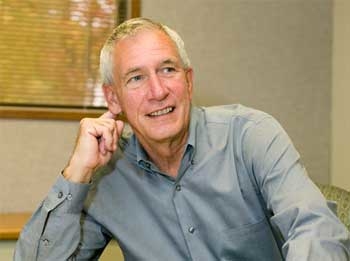Students, professors to pen commercialization plans for Lab
 (Download Image)
Erik Stenehjem
(Download Image)
Erik Stenehjem
Students from two California universities will have the opportunity this summer to build their own startup companies -- at least on paper -- through a unique program at Lawrence Livermore National Laboratory (LLNL).
Called the Entrepreneurship Academy, the program will allow eight students apiece from Vallejo-based Cal Maritime and Hayward-based California State University, East Bay to write commercialization plans for LLNL technologies.
The LLNL program is sponsored by the Tri-Valley Community Foundation, which is providing internships for the students and their faculty for the eight-week entrepreneurship projects.
"The purpose of the Entrepreneurship Academy is to do our part to strengthen the educational base for science, technology and business," said Erik Stenehjem, the director of the Lab's Industrial Partnerships Office. "We also want to grow the knowledge and understanding of what it takes to move breakthrough ideas into the marketplace within the Tri-Valley."
LLNL's pilot Entrepreneurship Academy will kick off for the students -- and the professors who will help guide their teams -- with a weeklong "boot camp" at the Lab, starting June 20.
Seven serial entrepreneurs who work with LLNL to commercialize breakthrough Livermore technologies will talk with the students and professors about their experiences bringing technologies into the marketplace. Between them, the seven business founders have started at least 14 companies in health care information technology, medical devices and software, among other fields.
The 16 students, who will be divided into four teams of four students (two with business majors and two with science or engineering majors), will develop commercialization plans for any of about 200 LLNL technologies available for licensing.
Among the Lab technologies for which the budding entrepreneurs will be able to draft commercialization plans are a two-stage combustion engine, ultra-wide-band radar and carbon nanotubes.
Within their commercialization plans, the students will identify a product based on the technology, pinpoint customers and level of interest, and also identify suppliers, distributors, retailers and others, Stenehjem said.
The commercialization plan program is based on a model successfully used in the United States and other nations, and developed by Steven Nichols, a mechanical engineering professor at the University of Texas, Austin.
"The model allows students to focus their attention on the entrepreneurial act - that is to identify the latent product possibilities in breakthrough scientific and engineering inventions," Stenehjem explained.
The students and their professors will work five days a week at their universities and in turn receive stipends - funded by the Tri-Valley Community Foundation - for developing the commercialization plans.
For the initial three weeks of the eight-week Entrepreneurship Academy, the student teams will study up to three LLNL technologies for candidate commercialization plans.
At that point, each team will be required to decide upon one technology to be the focus of their plan.
During the week of Aug. 8, the students and their professors will return to the Laboratory to make their final preparations for an Aug. 12 commercialization plan competition. Judges for the event will be drawn from LLNL's Entrepreneurs-in-Readiness program and from the Keiretsu Forum, the world's largest angel investor network.
It is estimated, Stenehjem said, in the nation's current economic environment that as many as 400,000 jobs need to be created each month to meet the challenge of the nation's structural unemployment.
"The Administration, through its StartUp America Program, is encouraging entrepreneurs and investors to start new companies to fill this gap," he said. "LLNL wants to help bring the skills needed to start companies to college seniors who have roots in the Tri-Valley."
Contact
Stephen P Wampler[email protected]
925-423-3107
Related Links
LLNL Industrial Partnerships OfficeTri-Valley Community Foundation
Cal Maritime Academy
California State University, East Bay
Tags
Academic EngagementStudents
Featured Articles







